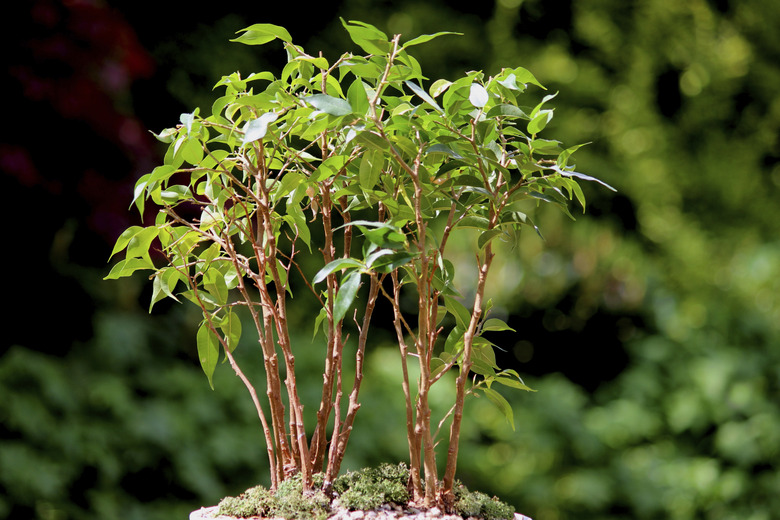How To Care For Ficus Benjamina
The glossy, evergreen foliage and graceful growth habit of weeping fig (Ficus benjamina, U.S. Department of Agriculture plant hardiness zones 9 through 11) make it a valued houseplant and landscaping plant. As a garden plant, it can live 40 to 150 years and usually grows to a mature height of up to 35 feet, according to a tree detail record published by the Cal Poly Urban Forest Ecosystems Institute. Information provided by the Missouri Botanical Garden states that as a houseplant, weeping fig generally reaches from 2 to 10 feet tall.
Watering Needs
During its growing season from spring to fall, weeping fig needs moist soil but should not be kept constantly wet. For houseplants, water the plant thoroughly until water comes through the drainage holes. Allow the top layer of soil to dry before watering again. In fall and winter when weeping fig isn't growing, reduce watering and allow 1 to 2 inches of soil at the top of the container to become dry. For weeping figs in the landscape, keep young plants well-watered for the first year, applying sufficient water to go beyond the root zone. Dig a small hole or use a probe to check water penetration. Give established trees supplemental water during times of drought in summer, up to once a week. If houseplants begin to drop leaves, it's usually a reaction to moving the plant or to stresses such as improper watering or light conditions. A common mistake is to increase watering, which can further stress the plant. Investigate the probable cause of leaf drop. The presence of yellow leaves dropping from the plant signals that the plant may need more water. When green leaves drop, it's usually a sign of overwatering or location change.
Pruning Guidelines
Prune weeping fig to keep it to size or to encourage bushiness. Clean all pruning tools with a cloth soaked in rubbing alcohol to avoid spreading diseases. White sap oozes from pruning cuts. Wear gloves, long sleeves and closed shoes because sap may irritate your skin. Protect surfaces such as pavement, concrete and flooring by laying down a tarp to catch the sap. Make pruning cuts just above a leaf or a leaf scar. You can prune weeping fig at any time, but a good time is in the spring before new growth begins.
Fertilizer Needs
Fertilize houseplants every three or four weeks during the spring and summer, using a half-strength solution of a water-soluble fertilizer such as 20-20-20. Mix 1/4 teaspoon with 2 quarts of water and apply the solution until it runs out the drainage holes. Gradually decrease the fertilizer applications as fall approaches, and stop fertilizing altogether during winter unless the plant is actively growing. For outdoor plants, use a controlled-release fertilizer such as 15-9-12, which lasts for 8 to 9 months. Apply it in spring before growth starts at the rate of about 3 pounds per 250 square feet. Calculate the footage from about 6 inches out from the trunk to about 6 inches beyond the tree's drip line. Mix the fertilizer into the top layer of soil and water well.
Frost Protection
Weeping figs are damaged by exposure to freezing temperatures. Bring container plants indoors before the first frost is predicted for your area. When freezing temperatures are predicted for landscaping plants, cover them with frost blankets, burlap or other fabric. Hold it off the foliage with stakes or a framework. Some trees may be too tall to cover. If damage occurs, remove the dead parts before new growth begins in spring.
Pests and Diseases
Weeping fig is generally pest- and disease-free. Sometimes spider mites, aphids, mealybugs or scale insects can infest plants. Remove these pests as soon as they're observed. Use a strong stream of water to wash off spider mites and a cotton swab dipped in rubbing alcohol to wipe off aphids and mealybugs. Scrape off scale insects with your fingernail..
References
- University of Florida IFAS Extension: Ficus Benjamina Weeping Fig
- Arizona State University: Ficus Benjamina
- University of Vermont: Ficus Benjamina
- Cal Poly Urban Forest Ecosystems Institute: Weeping Fig, Ficus Benjamina
- Proven Winners: The Dirt on Dirt — Potting Soil
- Missouri Botanical Garden: Ficus Benjamina
